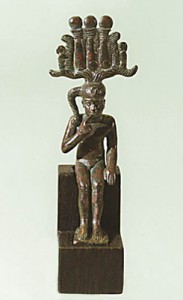Probably one of the best known of the child deities was Horus the Child, which was actually a name given to a number of related forms of divine infant. Most were the son of Osiris and the goddess Isis whom she birthed in the papyrus marshes of Chemmis (Khemmis) in the northeast Delta and raised in secret there in fear of the god Seth. However, Horus the Child could also be grouped with other divine parents at specific temples. At Medamud he was the son of Montu and Raettawy, for example.
 Horus the child might have more specific names. For example, in the Pyramid Texts this god is referred to as ‘the child with his finger in his mouth’. In that form, he was called Harherywadj, or ‘Horus upon his papyrus plants’ and sometimes as ‘Horus hidden behind the papyrus’. As ‘Horus upon his papyrus plant’, the child deity appears visually in a wall relief in the temple of Seti I at Abydos as a hawk on a column in the shape of papyrus reed. The child deity was most frequently called Harpakhered, Harpokrates in Greek, which translates as ‘Horus the Child’ and was often represented in this form as a vulnerable looking child seated on the lap of Isis while sucking his thumb, or he could be alone, depicted standing in the amuletic plaques known as cippi of Horus.
Horus the child might have more specific names. For example, in the Pyramid Texts this god is referred to as ‘the child with his finger in his mouth’. In that form, he was called Harherywadj, or ‘Horus upon his papyrus plants’ and sometimes as ‘Horus hidden behind the papyrus’. As ‘Horus upon his papyrus plant’, the child deity appears visually in a wall relief in the temple of Seti I at Abydos as a hawk on a column in the shape of papyrus reed. The child deity was most frequently called Harpakhered, Harpokrates in Greek, which translates as ‘Horus the Child’ and was often represented in this form as a vulnerable looking child seated on the lap of Isis while sucking his thumb, or he could be alone, depicted standing in the amuletic plaques known as cippi of Horus.
Note that at the top of some cippi of Horus, Bes is depicted. Bes could protect the solar child as part of the Hathor myth. However, the ‘cippi’ itself was that to act as an amuletic force warding off dangerous creatures. As Harsiese, he was ‘Horus son of Isis’, and was clearly identified in his role as the goddesses’ legitimate son and heir of Osiris. This was also the case with the related names, Horus iunmutef, or ‘Horus pillar of his mother’ and Harnedjitef, Harendotes in Greek, or ‘Horus savior of his father’.